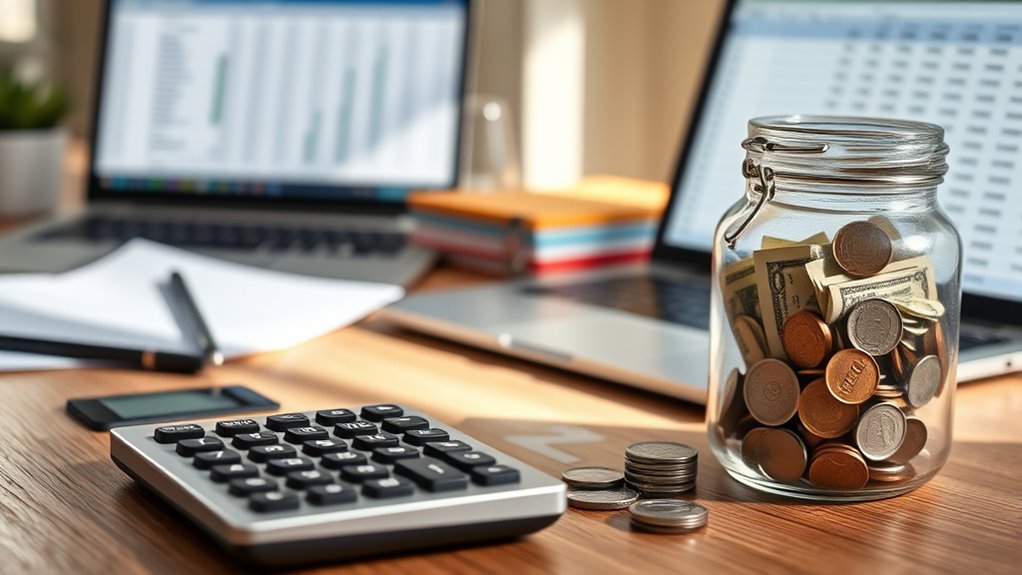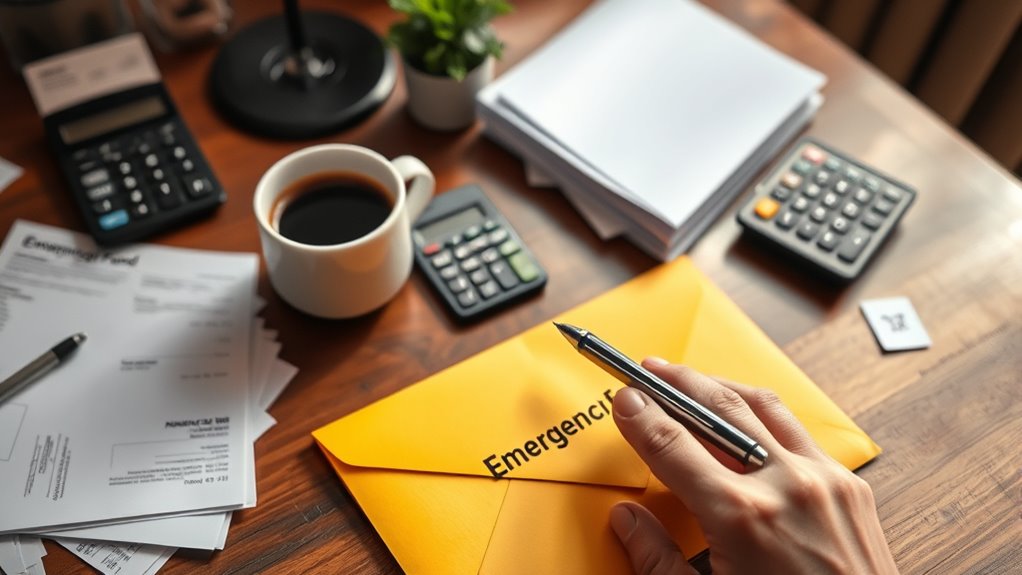Building an emergency fund during divorce is vital to safeguard your finances from unexpected expenses and income drops. Start by creating a detailed budget that covers your new living situation and legal costs, then set a realistic savings goal—aim for 3-6 months of expenses or at least $500–$1,000. Automate your savings and prioritize this fund before other spending. Keep building gradually, and you’ll find ways to stay on track, ensuring greater financial stability in uncertain times.
Key Takeaways
- Create a detailed budget accounting for post-divorce income and expenses to identify savings potential.
- Set a realistic savings goal, starting with $500–$1,000, and aim for 3–6 months of living expenses.
- Automate regular transfers to a separate, high-interest savings account immediately after each paycheck.
- Prioritize building your emergency fund before non-essential spending to ensure financial resilience.
- Review and adjust your savings plan periodically as your financial situation and expenses evolve.

Divorce can bring sudden financial challenges, making it essential to establish an emergency fund to protect your stability. When your income might drop by an average of 41%, and your expenses could increase due to legal fees, new housing costs, or childcare, having a financial cushion becomes critical. An emergency fund acts as a safety net, helping you cover unexpected expenses like car repairs, medical bills, or even sudden job loss without resorting to debt. Unfortunately, only about 38% of women prioritize building such a fund after divorce, despite the clear importance of financial security during this turbulent time. Without this safety net, you risk higher stress levels and greater vulnerability to economic shocks when you’re already maneuvering a major life transition.
Only 38% of women prioritize building an emergency fund after divorce, risking financial instability during the transition.
To start, you need a clear picture of your new financial landscape. Create a detailed budget that lists all post-divorce income sources and essential expenses, including housing, utilities, insurance, groceries, and childcare. This will help you determine a realistic savings goal. Experts recommend saving enough to cover three to six months of living expenses, but if resources are tight, beginning with a smaller target—say $500 to $1,000—provides a practical initial step. The key is to build gradually, consistently setting aside a portion of your income each month. Keep your emergency savings in a high-interest, easily accessible account separate from your daily checking account, so you’re less tempted to dip into it for non-emergencies.
Automating your savings can make a big difference. Set up automatic transfers from your checking account to your emergency fund right after each paycheck. This ensures you contribute regularly without needing to think about it, making saving less burdensome. Prioritize building this fund before allocating money toward non-essential items or long-term investments. Regularly review your savings target and adjust it as your financial situation evolves, especially if your expenses or income change. While it might be tempting to focus on paying off debts first, a balanced approach that includes emergency savings will give you greater financial resilience over time. Additionally, having an emergency fund can help you avoid high-interest debt if unexpected expenses arise, which is particularly important during the uncertain period following a divorce. Developing a financial safety net is a proactive step that can significantly reduce stress and improve your overall financial well-being during this challenging transition.
Building an emergency fund during divorce isn’t easy—many women haven’t managed household finances before or are overwhelmed by immediate costs. Legal fees, new living arrangements, and emotional stress can hinder saving efforts. However, setting realistic goals, automating contributions, and staying disciplined can gradually create a financial buffer. Remember, this fund isn’t just about money; it’s about peace of mind, giving you confidence to face unexpected challenges and ensuring your financial stability during one of life’s most uncertain periods.
Frequently Asked Questions
How Can I Start Saving if I Have No Income During Divorce?
If you have no income during divorce, start by exploring creative ways to generate cash, like selling unused items or monetizing hobbies. Seek temporary or gig work, and consider borrowing from trusted friends or family for initial support. Cut non-essential expenses, and prioritize building a small emergency fund with any available funds. Stay disciplined, set achievable savings goals, and automate deposits whenever possible to gradually grow your safety net.
What Are the Best Types of Accounts for an Emergency Fund?
Think of your emergency fund as a safety net woven from the strongest threads. The best accounts for this are high-yield online savings accounts and money market accounts, both FDIC insured and offering quick access. These accounts balance safety and liquidity, so you can grab your cash when life throws a curveball. Avoid physical cash outside banks, as it lacks protection and can be lost or stolen easily.
How Much Should I Aim to Save for Emergencies During Divorce?
You should aim to save three to six months’ worth of essential living expenses during divorce. This amount covers bills, necessities, and new costs from establishing a separate household. Depending on your situation—like income stability, legal fees, or new expenses—you might want to save even more, up to nine months. Start small, automate your savings, and gradually build toward your target to make certain you’re financially secure during this shift.
Can I Access My Emergency Fund if I Need to Pay Legal Fees?
Yes, you can access your emergency fund to pay legal fees if needed. It’s meant for urgent expenses, including divorce-related costs like attorney payments. Just make sure you have organized your financial documents and planned ahead, so you can justify the withdrawal. Using your emergency fund can help you avoid high-interest loans or credit card debt, providing financial stability during this stressful time.
How Do I Rebuild My Emergency Fund After Divorce Is Finalized?
Imagine rebuilding a house after a storm—you start with a solid foundation. To rebuild your emergency fund post-divorce, first assess your finances thoroughly. Create a realistic budget, prioritize saving 3-6 months of expenses, and identify extra income sources. Automate deposits into a dedicated account, track progress, and stay disciplined. Over time, consistent effort will turn your financial wreckage into a resilient safety net.
Conclusion
Building an emergency fund during divorce is like planting seeds in a storm—you’re nurturing stability amid chaos. As you save steadily, you’re anchoring yourself to a sturdy tree, roots growing stronger with each deposit. Though the winds may howl and the skies stay cloudy, your financial garden will bloom with resilience. Keep tending to it, and watch how these small acts transform chaos into a sanctuary—your safe harbor in life’s unpredictable seas.










